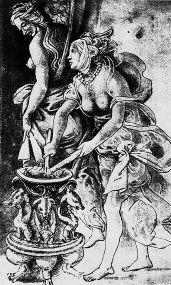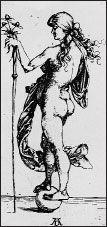Witchcraft Medicine: Healing Arts, Shamanic Practices, and Forbidden Plants (55 page)
Read Witchcraft Medicine: Healing Arts, Shamanic Practices, and Forbidden Plants Online
Authors: Claudia Müller-Ebeling,Christian Rätsch,Ph.D. Wolf-Dieter Storl

In Baldung’s picture Atropos is represented by the old woman, Clotho is the motherly spinner, and Lachesis measures and distributes fate—in this instance with a suggestive sneer.
The Norns were the Germanic equivalent of the goddesses of fate. They lived beneath the World Tree, the ash tree Yggdrasil, and were called Urdh (fate that has already become, or the past), Verdandi (fate that is becoming, or the future), and Skuld (present).
58
Like the witches, the Norns combined plant knowledge with the powers of divination. If one compares the Germanic “evergreen ash” (yew) with the leafless tree in Baldung’s woodcut, one sees a great discrepancy between the two. Though its trunk was perpetually rotting and its roots eternally gnawed by the dragon Nidhogg, Yggdrasil, unlike the tree behind the three women in the woodcut, always remained vibrantly green with life. The reason for this was that the Norns constantly looked after its welfare, patching the rooted portions of the trunk with healing clay and sprinkling water they had drawn from the well of fate over it. This difference between the tree images was not necessarily based on the personal perspective of the artist, who nevertheless demonized heathendom as a dead religion. More likely the difference is based on the fact that the reigning religion (which significantly determined the political reality in Germany in the early modern era) influenced the humanistic art of the German Renaissance and colored it with such an interpretive position. At the start of the sixteenth century—during the time of societal and religious unrest and on the eve of the religious wars, when terrible epidemics such as the plague and syphilis threatened the life of individuals and the hygienic conditions under which the threads of life of many women and children were severed—the inescapable fate awaiting every human being must have seemed particularly threatening.
In Greek sources it is said that “in life only the Moirai alone—and none of the other eternal gods”—see and know everything about humans. Some classical authors present even Zeus as subject to the will of the Morai. Such an idea is unimaginably sinful for Christians, for to them God is supreme. A dialogue between Sofia and Saulin written in 1584 by Giordano Bruno (1995: 247) gives us a means for thinking about this abomination. Giordano quotes, in the figure of Saulin, the Roman poet Seneca:
Fate leads us, we shun destiny, / The fine threads of the winding spindle / Does not permit the release of worrisome thought. / What we do and endure from above is it / Pre-determined, and from there comes everything. / The unforgiving sister of fate / Never pulls the fallen threads back up again, / According to a certain order the Parcae work, / While from us ever history swings against us which we do not know.”
To Christians, on the contrary, God alone determines human life and the order of the universe. Those decisions are not made by elemental goddesses. According to the Christian perspective, when the Parcae (or the witches) are able to influence the weather with their distaffs, as we have seen in pictorial examples, then the devil that God has sent to put humans to the test must be part of the game.
But why should the distaff be an indication that the witch, as sorceress and soothsayer, threatens the divine order? Let’s once again consult Hans Baldung Grien. In his pen-and-ink drawing
Hercules and Omphale,
in the collection of the Paris School of Fine Arts, the powerful Hercules takes the distaff from the Lydian queen Omphale while she wears his lion fur and carries his cudgel. This illustration, based on an ancient Greek myth, is a vicious allusion to the Christian belief that such a woman turns the natural—in other words, the divine—order on its head. The text that Baldung wrote in the beam on the left edge of the picture—“What does Cupid not conquer when the grim hand of the lion killer is sentenced to spinning work, which makes heroes into weaklings”—documented the general consensus of the time about such a reversal, an attitude that persisted at least into the eighteenth century. The poet August Kotzebue was quoted with a similar verse in
Grimm’s Dictionary
under the entry
distaff,
where he defined it as a typical work tool of women. Noble men must “like Hippocrates / strive toward higher things / and should not, like Hercules / play with distaffs.”
In the same way, in Albrecht Dürer’s 1505–1507 copper engraving of the allegory “Witch with Cupids” (see the illustration on page 176), the old woman, with the haggard body and drooping breasts, rides backward on a buck through the air, contrary to the nature of God. The goat veers to the right but the hair of the witch, who sits backward holding on to the horns, does not blow in the same direction as her strange mount (which is not moving on the earth), but rather as if the wind, which also drives on a hailstorm, was coming from the left, the western direction. The cupids also twist in strange ways as they laboriously attempt to pull themselves up from the ground. The presence of these diminutive gods of love makes sense in either the context of a lover who shoots a beloved with arrows or as companions to the love goddesses Aphrodite and Venus. All traces of the lover are missing from Dürer’s print; however, Venus is present, although she has mutated into an ugly old woman.
An examination of art history research could easily substantiate that the famous German artist Dürer was actually inspired by classical paintings.
59
During antiquity art depicted flying rams that carried Phrixos and Helle over the sea,
60
as well as Aphrodite Epitragidia (“she who rides on a goat”). But why did Dürer portray his Venus with such an angry expression? The classical sources offer a point of reference for such a transformation—Aphrodite as Urania, an underworld goddess who belonged to the world of the dead and was worshipped as the eldest Moirai. In the second century after Christ, Pausanias, who came from Asia Minor, reported in his travels through Greece of an abstract square shrine of Aphrodite at the Acropolis: “The inscription said that Aphrodite Ourania was the eldest of the so-called Moirai” (Pausanias,
Itinerary of Greece
I: 104). The love goddess belongs entirely in the environment of the goddesses of fate.

This drawing by Filippino Lippi, who was the fruit of a forbidden relationship between a nun and the monk and painter Filippo Lippi, was executed entirely within the Renaissance tradition of the emerging interest in antiquity, as can be seen in the way the witches are depicted around a brewing cauldron, like classical priestesses. The three-footed vessel is decorated with the three dogs’ heads of Hecate, as well as three harpies, or sphinxes. This is reminiscent of the magical powers of the classical witch-goddess and the powers that bubble out of the cauldron of mystical knowledge. (Drawing, Florence, Uffizi, c. 1480.)
From the Goddess to the Witch
While the northern lands of fifteenth-century Europe fought hard for a reformation of the religious and moral foundations of spiritual life, sunny Italy opened itself up with all of its senses to the rediscovery of classical sculptures of the gods as well as to texts that were bought from the cloisters by the art enthusiast Cosimo de’Medici. An educated Italian intelligentsia conveyed a new concept of nature’s beauty to painters and visualized the congenial side of the human character more than the sinful. This stark difference between northern and southern Europe is mirrored in the art of the time. While the Italian Renaissance investigated new realms such as human anatomy and perspective, in the Netherlands and in Germanic lands pictures of the infernal hell, of witches’ kitchens, and of dances of the dead were created. It is barely comprehensible that the panel paintings of Hieronymus Bosch were created at the same time as the master works of Leonardo, Raphael, and Michelangelo!
This difference between these cultures is also recognizable in the few Italian pictures of witches. For example, in a drawing attributed to Filippino Lippi from the 1480s, two lovely youthful women with bared breasts stir a steaming brew in a decorative vessel that rests upon animal paws and is ornamented with pig heads and harpies. Without the title (probably added later) and the classical-looking cauldron, the two women with flowing hair and clothes could be identified as priestesses from antiquity. If one studied each of the surprisingly few demonized heathen women to be found in southern European art of this time, then one could agree with Jules Michelet: “This innocent woman conceals a secret inside that she has never revealed to the Church. She keeps the memory of the poor old gods in her heart, with which she has empathy and who have been degraded into ghosts” (Michelet, 1952: 46).
Frau Venus
The heathen world was devoted to happiness in this life. From the myths that have been handed down it is clear that the gods and goddesses the pagans worshipped behaved as if they shared those sentiments, if anything with even less restraint. Equally wholesome were the Greek and Roman sculptures the Renaissance man brought into the light of day from their centuries-long sleep behind the thorny hedge of roses.
Upon closer examination of the images of witches it becomes apparent that the entire complex of the Aphrodite cult rediscovered in the Renaissance was transferred to the witch over the course of religious unrest and the radical transformation of society that took place in the fifteenth and sixteenth centuries. This transference was especially prevalent in the lands shaken by the Reformation, where Protestant theologians utilized the discoveries of their more tolerant colleagues in the south to refine their condemnation of the witch. Thus we encounter the love goddess as a young witch with a beautiful body who follows the example of Aphrodite Kallipygos, she “with the pretty posterior.” A similarly seductive view of her back is shown in a copper engraving from 1612.
61
The love goddess, who knows about love potions—which were named
aphrodisiacs
after her—became a witch who made men impotent. In Sparta she was honored as Ambologera, she “who banishes age”—an ability that fell under the domain of healers and was also conceived as black magic in the early-modern-era concept of witches. Aphrodite Genetyllis, in her function as the guardian of births, also belongs in this context. In 1544 Leonhard Culman, a Nuremberg preacher of humanist tendencies, wrote a moralizing drama that brought the classic world of the gods into this Renaissance city. In the drama he accorded the devil these words:

Allegories, from left to right: Fortuna on Dürer’s woodcut (1500), with her distaff and long hair reminiscent of those of a witch.

This Venus, who is gazing into a mirror and has a horned animal at her feet, could also be an allegory of Luxuria. (Woodcut from Paracelsus, 1537.)

This anonymous print from the 16th century depicts the personification of lust with the ram as an accompanying animal.